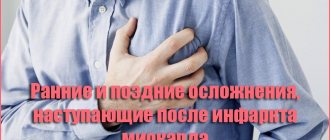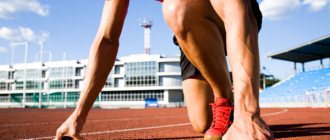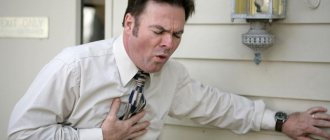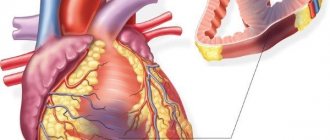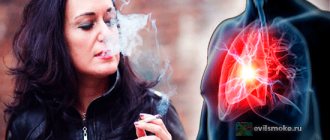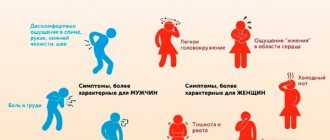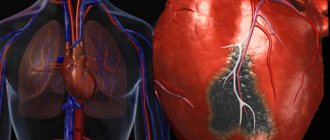Acute heart pathology today is one of the main causes of death in the working population, therefore adequate physical activity after myocardial infarction contributes to the speedy rehabilitation of patients. In cardiological practice, special techniques have been developed that allow patients to smoothly return to the level of performance after this illness.
Restoration of physical activity for people who have suffered necrosis of a section of the heart muscle usually begins in the hospital. Rehabilitation of patients after this cardiac pathology takes from 4 months to a year, depending on the severity of the disease.
Features of physical activity and exercise therapy in a cardiology hospital
Modern medicine adheres to two main postulates for the management of cardiac patients. First of all, experts include the early start of active physical activity in patients. In this case, the goal is to early discharge the patient from the hospital and transfer him to sanatorium-resort treatment.
For all people who have suffered a myocardial infarction, an individual recovery program must be developed in the first month after the illness. It all depends on the personal characteristics of the patient’s body, the severity of the condition and the expected cardiac prognosis.
All the time allocated for treatment of myocardial infarction in a hospital setting is conventionally divided into four periods. This allows the attending physician and exercise therapy specialists to calculate the most gentle amount of loads permissible for the patient. Transfer from one group of physical exercises to another is carried out by a council of doctors from a given medical institution.
Physical activity is indicated for a patient after a myocardial infarction already on the 3rd - 4th day of hospital stay. After stopping the acute stage of the disease or the complications caused by it, you can begin rehabilitation measures:
- For the first 2 - 3 days, the patient observes strict bed rest; the body is allowed to turn on the right side for eating and using a bedpan.
- From days 4 to 7, the patient is allowed to move independently in bed. In this case, the patient can sit up in bed only in the presence of medical personnel for a fairly limited time. Physical exercises during this period include raising and spreading your arms to the sides, exercises for the chest and abdominals. This load is called exercise therapy complex No. 1 and is usually accompanied by a special massage.
- The second week corresponds to a set of physical therapy exercises No. 2 and includes slow walking around the ward and performing limited exercises in a sitting position.
- Set of exercises No. 3 is intended for patients who have been in the hospital for more than 14 days. They are allowed to walk in the corridor of the department, slowly climb the stairs up to 2 floors, and complete self-care, including water procedures. The performance of physical exercises is supervised by a physical therapy specialist to practice correct breathing movements during exercise.
- After 3 weeks of rehabilitation, patients are already strong enough and can afford to walk outdoors for 45 - 60 minutes. Set of exercises No. 4, recommended for this period, includes loads on all muscle groups. The main method is the use of a bicycle ergometer and a treadmill.
The course of treatment for myocardial infarction and its consequences in a hospital setting is usually designed for 1 month, after which the patient is recommended to undergo sanatorium-resort treatment, where exercise therapy will be more varied and intense.
Watch the video about the treatment of myocardial infarction:
Shock is our way
The results of this study are even more shocking. They disprove many things we have been taught to believe. For example, early atherosclerosis is promoted not only by very intense loads, but also by ordinary ones, which we are strongly recommended to do .
Subscribe to our INSTAGRAM account!
To find out all this, we turned not to Internet publications, but to the original source: an article in the scientific journal Mayo Clinic Proceedings. It is published by the world-famous private Mayo Clinic. This is a huge and reputable medical institution, which employs about 60 thousand people, of which 4,500 (doctors and scientists) are located in the state of Minnesota in the relatively small city of Rochester. The journals published here enjoy authority in the scientific community. So you need to approach your research accordingly.
If you carefully study the table from a scientific article (we adapted it for the general reader), it turns out that high physical activity throughout life increases the risk of developing atherosclerosis at an earlier age by as much as 80% (by 71% for women and by 86% for women). men).
That is, people who regularly exercised themselves in the gym, on a treadmill, on a bicycle, etc., had atherosclerosis almost twice as often as compared to those who did not lead a very active lifestyle. The latter benefited even those who acted in accordance with the recommendations of doctors: they devoted about 150 minutes a week to physical activity (in the USA this is included in the official recommendations for patients). This load increased the risk of developing atherosclerosis by 11%.
The scientists who conducted the research were amazed: they expected the opposite results. There is an established opinion that when playing sports, cholesterol is reduced, glucose in the blood and fats under the skin are burned, the heart and blood vessels are trained, and all this delays the onset of the development of atherosclerosis. Therefore, millions of people in the world almost every day “run away from a heart attack” or delay its approach by doing fitness, cycling or loading themselves with some other types of physical activity.
Sanatorium treatment of the consequences of myocardial infarction
After returning home after hospitalization, the patient should seek advice from a cardiologist at his place of residence within 2–3 days. A person is registered at a dispensary and in 90% of cases is sent for further rehabilitation to a cardiological sanatorium. The recovery period is usually 4 - 5 weeks.
At a resort medical institution, the patient undergoes a second examination by specialists to determine possible physical activity; the conclusion about the state of health is based on a bicycle ergometer test.
Dosed physical activity after myocardial infarction forms the basis of the recovery cycle of any patient, and the cardiological sanatorium can provide them in full. In addition, the course of sanatorium rehabilitation necessarily includes drug therapy, assistance from a psychiatrist and psychotherapist, and a therapeutic diet.
Physical exercises prescribed by exercise therapy specialists should lead to a significant improvement in myocardial nutrition, which will lead to an increase in the functional capabilities of the heart muscle. Physical education stimulates metabolic processes in the cells of the entire human body, and heart cells are no exception.
All training is aimed at the rehabilitation of the patient after a myocardial infarction. In addition to various gymnastic exercises, in order to quickly return the patient to normal life, the sanatorium widely uses massage, a swimming pool and a walking path, or health path.
However, there are also contraindications for prescribing exercise therapy in sanatorium conditions. These include:
- the possibility of developing aneurysms of the heart and large vessels;
- various types of arrhythmias;
- severe chronic heart failure.
For this category of patients, the rehabilitation program after myocardial infarction is developed individually.
Benefits of jogging
So, even beginners and people who are not in the best physical shape can do this type of running pace and technique. How is jogging useful and what can you achieve with it?
Running is indeed very beneficial for the human cardiovascular system, as it has a beneficial effect on small vessels. Physical inactivity leads to impaired blood supply to tissues and atrophy of a large number of capillaries. Proper jogging maintains a given intensity of heart activity and “opens” collapsed capillaries, also promoting their growth into depleted areas of tissue.
Blood microcirculation promotes the functioning of the endocrine system: the production of hormones is improved and activated. In general, jogging speeds up metabolism, which rejuvenates the body and increases its defenses. Lactic acid and carbon dioxide act as stimulants, the content of which increases during jogging.
Normalization of blood pressure is another advantage of jogging: when the heart rate reaches 120-150 beats per minute, peripheral vessels dilate and their resistance decreases.
The feeling of happiness and pleasure is noted by all jogging lovers. It occurs due to the increased production of endorphins. The effects of these hormones continue for an hour after your run. A morning run helps eliminate excess hormones and calm your nerves, while an evening run helps to recharge your batteries after a long day of work.
Finally, jogging can help you lose weight by burning more calories in the process. Therefore, it is recommended to most people trying to lose weight as a relatively light exercise.
What can patients who have had a heart attack do at home?
After staying in the hospital, the patient returns to the cardiologist, who records the current condition of the sick person in the outpatient card and gives recommendations on further treatment and regimen. This program necessarily includes work with a psychologist, advice on expanding physical activity.
The patient receives regular physical therapy in the outpatient department 3-4 times a week. In this case, specialists use four types of gymnastic exercises, which can be gentle, gentle-training and training. In 45% of cases, an intensive method of recovery with constant monitoring of cardiac activity is used for rehabilitation in the post-infarction period.
At home, the former patient is advised to regularly walk in the fresh air, while monitoring the distance. You should not give up water treatments in a pool or open water. Swimming is one of the best sports that allows dosed impact on the heart muscle.
The patient must constantly monitor the load after myocardial infarction, combine the active phase with rest, and in case of any alarming symptom of the heart, seek help from a doctor.
We recommend reading the article about the difference between heart pain and neuralgia. From it you will learn about the manifestations of pain caused by heart ailments and the manifestations of neuralgia, and the provision of early assistance.
You need to run wisely
Not only wisely, but also with a stopwatch and a bottle of water. If your doctor has approved jogging (and for any chronic diseases you need to consult a doctor in advance), then you need to treat this with responsibility. First of all, carefully study the correct running technique, preferably using video lessons - it’s more clear.
If you are overweight or in poor physical shape, it is better to start with brisk walking and only then, after 3-4 weeks, run a little. Pulse monitoring should be regular: at the first stage, the pulse should not exceed 18-20 beats in 10 seconds. If it exceeds this value (120 beats per minute), you need to start walking. Jogging starts at 10 minutes, and jogging three times a week is enough. Each week the time can be increased by 10%. Do not allow your body to dehydrate: water should always be at hand, otherwise you risk simply losing consciousness while running “for your health.”
Video from YouTube on the topic of the article:
Subtleties of nutrition
– It is clear that it is impossible to become completely healthy after a heart attack. However, it is probably not only possible, but also necessary, to mitigate its negative consequences. Tell us what needs to be done for this?
– It is necessary to reduce blood cholesterol levels. It is found in our food. The richest foods in cholesterol are fish roe, egg yolk, liver, kidneys, brains, dairy products, and animal fat.
In addition, you need to sharply limit all sweets, especially simple types of sugars, which are quickly absorbed, which contributes to a sharp rise in blood sugar levels, and this, in turn, leads to the development of carbohydrate intolerance syndrome, metabolic syndrome, diabetes mellitus, which in aggravate the course of atherosclerosis, hypertension, and heart attack to a greater extent.
Everything that gives food beauty and taste, as a rule, contains components harmful to the body of a sick person. Therefore, you need to follow a diet. The essence of the diet comes down to not overeating, not eating when you don’t really want to, for example, for company or so as not to offend the hostess.
You should especially limit your consumption of animal fats. A lot of fat, and therefore cholesterol, is contained in the skin of birds. This is why eating chicken skin is extremely undesirable for people who have had a heart attack. You should choose a skinny bird, or even better - chickens. Turkey meat is very good, it does not contain bad fat, is quite nutritious and tasty.
You need to eat at least 400 grams of fruits and vegetables. Potatoes don't count because they're pure starch. But cabbage can be eaten without restrictions, both boiled and in the form of salads. It is advisable to eat low-calorie bread made from flour that is not very finely ground. The most healthy are coarse types of bread with bran admixtures.
Our people have a bad habit of ending any feast with a so-called dessert, which includes pastries, cakes, and candies. And this is after the person has eaten both meat and fat! If you really can’t bear to give up dessert altogether, replace sweets with dried fruits.
Set of exercises
Naturally, after a person has suffered a major heart attack, the attending physician immediately prescribes a certain set of exercise therapy classes. But after complete rehabilitation, do not forget that physical exercise is the main condition for complete recovery. And as practice shows, many who went in for sports after a heart attack are less susceptible to repeated attacks. Therefore, as soon as you get home, you need to do certain physical exercises. Let's consider a set of preferred gymnastics after a heart attack:
- The first exercise should be performed in a sitting position. Your arms should be completely lowered and your legs should be brought together. As you inhale, you should alternately raise both arms. As you exhale, they should be lowered. You will have to raise each arm about 5 times.
- The second exercise is performed in a standing position. The legs are brought together. Your arms should be bent at the elbows to the maximum and raised shoulder-width apart parallel to the floor surface. After this, you should perform about 5 circular movements counterclockwise and the same number of movements, but clockwise.
- To perform the next exercise, you need to bring your legs together and extend your arms to both sides. Then, with each inhalation, you need to bend your left leg at the knee and press it to your chest and stomach, while you can help yourself with your hands. As you exhale, the leg should lower to its original position. With one leg, this exercise should be repeated about 3-5 times. The same steps must be repeated with the right leg.
- For the next exercise, you need to place your feet shoulder-width apart and place your hands on your waist. With each inhalation, it is necessary to tilt the body to the sides. As you exhale, you need to return the torso to the starting position. In each direction you need to make about 3-5 tilts.
- The following exercise should be performed with your feet shoulder-width apart. Hands should be spread in both directions. With each inhalation, you should raise both arms and lower them smoothly straight to your knees. In this case, you need to ensure that the head is placed in line with the body. With each exhalation, the arms should be returned to the starting position. Perform the exercise about 5 times.
- Next, you need to get into the starting position while standing. Lower your arms and place your feet shoulder-width apart. With each inhalation, you need to carefully move your right arm and leg to the side, while holding them in one position for at least 2-3 seconds. As you exhale, return your leg and arm to the starting position. On the right and left sides, the exercise must be repeated 5 times.
Take care of your health!
Source: tonometra.net
A quarter of a century of observations
But here, for the first time, scientists decided to look at how the level of physical activity throughout life affects blood vessels . Observation of volunteers continued for 25 years. Their health status was first assessed when they were between 18 and 30 years old. And then, over the course of a quarter of a century, we met with them, communicated, they filled out questionnaires, and at the end of the observation period, everyone had a computed tomography scan of the chest.
The study showed the true condition of the vessels, how much calcium was deposited on their walls and how much atherosclerotic plaques there were: it is these changes that lead over time to heart attacks, strokes and other cardiovascular disasters.
Based on adherence to an active lifestyle, all observed people were divided into three groups.
The first included the most passive ones; they did not do physical exercise even the prescribed 150 minutes a week, that is, they did not run, did not jump, and did not even walk at a brisk pace for 20-25 minutes a day.
The latter performed, and sometimes exceeded, this level of physical activity.
And the third group included the most active ones; over the course of these years they tortured themselves with physical activity for at least 450 minutes a week, that is, if the exercises were daily, they would spend more than an hour on them. In recent years, there have been noticeably more such people, it is even fashionable, and there is a whole sports industry working for this audience. And these people, who were involved in a serious race for health, were 80% more likely to have worse blood vessels than those who were lazy to do the sports minimum.
How to explain this?
Medical view
“Acute deaths during marathons, as well as when running and walking long distances, do occur, and have two main causes,” says psychoendocrinologist and president of the Russian Diabetes Association Mikhail Bogomolov . - Firstly, death may be associated with hypoglycemia - a sharp drop in blood glucose levels. To put it simply, distance racers have a high consumption of glucose to provide energy, and it mainly goes to the muscles. When the body's reserves of this sugar are depleted, there is often not enough supply for the brain. As a result, life support centers may shut down.
Question answer
Should you undergo a medical examination before the marathon? By the way, the topic of doping initially arose precisely with such deaths of marathon runners at a distance. They took whiskey, and ethyl alcohol helps lower blood glucose. When they began to study this problem, it turned out that alcohol was to blame. It became the first doping banned in sports.
The second common cause of death in marathon runners is related to cardiac ischemia (insufficient flow of oxygen from the blood). There may be problems with the blood vessels of the heart that do not manifest themselves in everyday life. And at a distance, when the need for oxygen is sharply increased, they are not able to provide the necessary blood flow. This leads to heart attacks or even cardiac arrest.”
According to some observations, sudden death associated with cardiac problems during such competitions in athletes 30 years of age and older is usually associated with ischemia or acute myocardial infarction. And in younger people, genetics is most often to blame. These are hereditary diseases such as hypertrophic and dilated cardiomyopathies, anomalies in the development of coronary vessels, and long QT interval syndrome. The latter diagnosis is easy to make using an ECG. The first two are done using echocardiography, but this is not required when conducting amateur marathons. But congenital anomalies in the development of heart vessels are not detected even in high-level professional athletes. To do this, you need to perform a coronary angiography. This serious study, involving the insertion of a catheter into the arteries, is done to diagnose coronary heart disease and heart attacks.
Keep a journal and eat right. How to properly prepare for a marathon? More details


